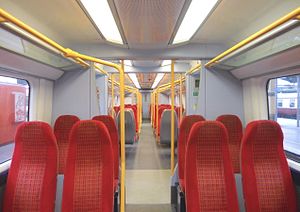British Rail Class 458
| British Rail Class 458 Juniper | |
|---|---|

Class 458/5 No. 458502 at London Waterloo
|
|

The interior of a refurbished Class 458/5
|
|
| In service | 2000 – Current |
| Manufacturer | Alstom |
| Built at | Washwood Heath |
| Family name | Juniper |
| Replaced | |
| Constructed | 1998–2002 |
| Refurbishment | Refreshed: 2008-2010 Refurbished: 2013-2016 |
| Number built | 30 trainsets (As original 458/0) |
| Formation | 4/5 cars per trainset 458/0 (As built): DMCO-PTSO-TSO-DMCO 458/5 (As rebuilt): DMSO-TSOL-TSOL-MSO-DMSO |
| Fleet numbers | 458001–458030 (re-numbering to:458501-458536) |
| Operator(s) | South West Trains |
| Specifications | |
| Car length | DMCO 21.01 m (68.9 ft) MSO/PTSO 19.94 m (65.4 ft) |
| Width | 2.80 m (9 ft 2 in) |
| Height | 3.77 m (12 ft 4 in) |
| Maximum speed |
458/0 100 mph (161 km/h) 458/5 75 mph (121 km/h) |
| Weight | 164.3 t (161.7 long tons; 181.1 short tons) |
| Electric system(s) | 750 V DC Third rail |
| Braking system(s) | Air, Regenerative |
| Track gauge | 1,435 mm (4 ft 8 1⁄2 in) standard gauge |
The South West Trains (SWT) Class 458 (previously also known as 4JOP) outer-suburban electric multiple units were built by Alstom at Washwood Heath between 1998 and 2002. The 30 four-car units are part of Alstom's Juniper family of trains, which also includes Classes 334 and 460.
These trains have been used by SWT since they were built. From 2013 they were merged with the mechanically similar Class 460 fleet and reconfigured into 36 five-cars units, which were being designated Class 458/5 (or 5JOP).
Thirty of these 4-car trains were ordered by SWT in 1998, to create extra capacity and to replace some of the ageing Class 411 (4CEP) units. Deliveries of these units began in 1998. They were delivered in SWT's mainline livery of mainly white, with a blue band, and red/orange 'swish' at cab ends. They are the only Juniper EMUs to feature end gangways.
The units were numbered 458001-030. Each unit was formed from two outer driving motors, an intermediate trailer, and an intermediate motor. The maximum speed is 100 miles per hour (161 km/h).
The class initially suffered from major technical problems, such as leaky roofs and failing electronics. In 2004, when the full fleet was in service, reliability was so poor that SWT planned to return them to the leasing company and replace them with new Class 450 Desiro trains. At that time, the trains only managed an average of 4,300 miles (6,900 km) between failures, compared with an average of 21,000 miles (34,000 km) for a Class 450 Desiro and 50,000 miles (80,000 km) for the previous slam-door trains. Subsequently, reliability improved sufficiently to allow the trains to be retained. By the end of 2012, the fleet had achieved an average of 106,049 miles (170,669 km) between failures, becoming the most reliable fleet in Britain and the first fleet to achieve a 6-figure rating. As a result, the fleet was awarded a Modern Railways Golden Spanner award in the New Generation EMU category on 23 November 2012.
...
Wikipedia
